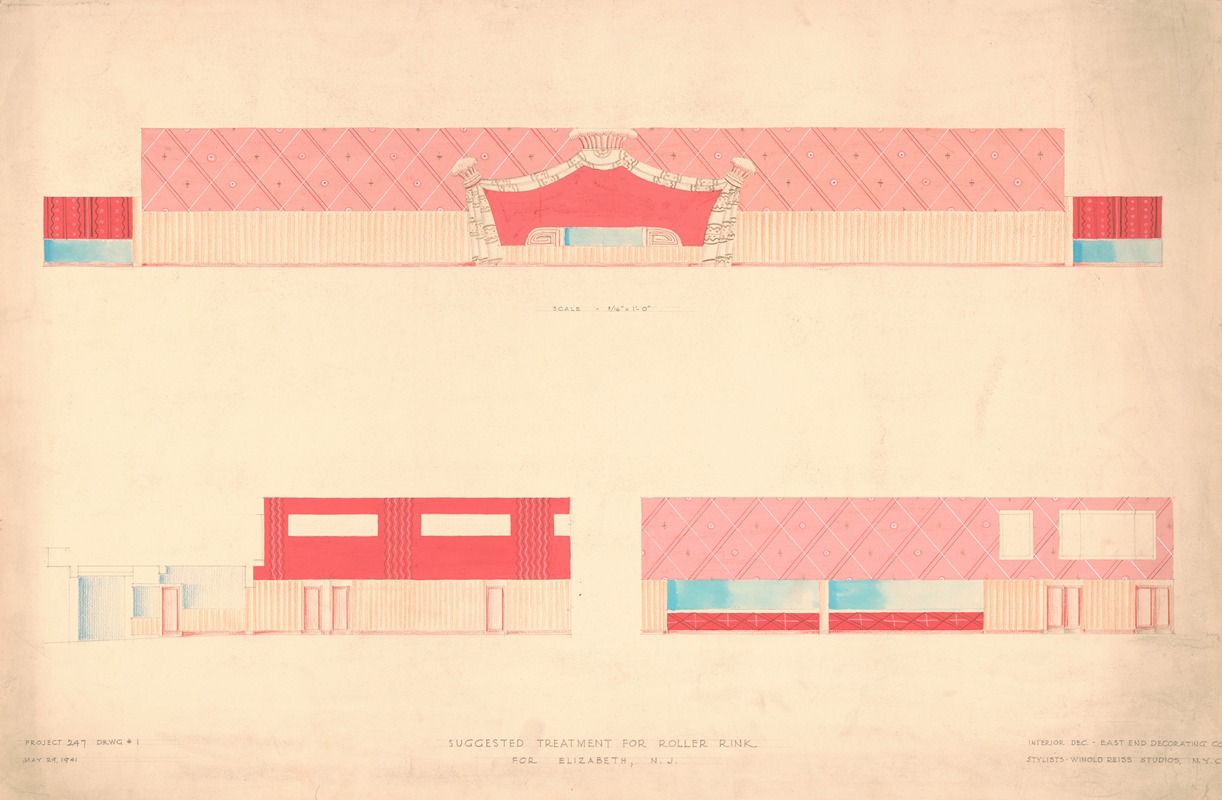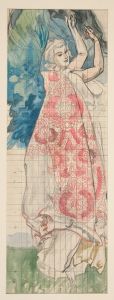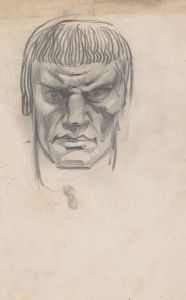
Proposed treatment for roller rink, Elizabeth, N.J.] [Wall elevations, royal scheme
A hand-painted replica of Winold Reiss’s masterpiece Proposed treatment for roller rink, Elizabeth, N.J.] [Wall elevations, royal scheme, meticulously crafted by professional artists to capture the true essence of the original. Each piece is created with museum-quality canvas and rare mineral pigments, carefully painted by experienced artists with delicate brushstrokes and rich, layered colors to perfectly recreate the texture of the original artwork. Unlike machine-printed reproductions, this hand-painted version brings the painting to life, infused with the artist’s emotions and skill in every stroke. Whether for personal collection or home decoration, it instantly elevates the artistic atmosphere of any space.
Winold Reiss, a German-American artist and designer, is known for his contributions to modernist art and design in the early to mid-20th century. One of his works, titled Proposed treatment for roller rink, Elizabeth, N.J.: Wall elevations, royal scheme, reflects his innovative approach to architectural and interior design. This piece, created as a conceptual design, showcases Reiss's ability to blend vibrant colors, geometric patterns, and cultural influences into functional spaces.
The artwork was part of a proposal for the decoration of a roller rink in Elizabeth, New Jersey. Reiss's design for the wall elevations, referred to as the "royal scheme," demonstrates his characteristic use of bold, symmetrical patterns and dynamic compositions. His work often incorporated elements of Art Deco and modernist aesthetics, which were popular during the time. The design likely aimed to create an engaging and visually stimulating environment for the roller rink, aligning with the entertainment and leisure culture of the era.
Winold Reiss was particularly noted for his versatility, working across various mediums and disciplines, including murals, portraits, and interior design. His designs often reflected a synthesis of European artistic traditions and American cultural themes. While this specific project for the roller rink may not have been realized, it stands as an example of his creative vision and his contributions to the decorative arts.
The exact date of the proposal is not documented, but it is consistent with Reiss's active period in the 1920s and 1930s, when he was involved in numerous architectural and decorative projects. His work during this time often emphasized the integration of art into public and commercial spaces, aiming to make art accessible and functional.
The Proposed treatment for roller rink, Elizabeth, N.J. is preserved as part of Reiss's legacy, offering insight into his design process and artistic philosophy. It is an example of how he sought to transform everyday spaces into works of art, enhancing the aesthetic experience of those who used them. Further details about the project's development or implementation are not available, but the design remains a testament to Reiss's innovative approach to art and design.









![Designs for Shellball Apartments, 8300 Talbot St. at Lefferts Blvd., Kew Gardens, New York, NY.] [Perspective drawing of lobby](/imgs/249322/s/winold-reiss-designs-for-shellball-apartments-8300-talbot-st-at-lefferts-blvd-kew-gardens-new-york-ny-perspective-drawing-of-lobby-e19c70e0.jpg)
![Drawings for proposed decorations of Mike Lyman’s Restaurant, 424 W. Sixth St. Los Angeles, CA.] [Scheme 1; elevation – K – showing bar](/imgs/249336/s/winold-reiss-drawings-for-proposed-decorations-of-mike-lymans-restaurant-424-w-sixth-st-los-angeles-ca-scheme-1-elevation-k-showing-bar-6d934644.jpg)

![Interior design drawings for unidentified rooms.] [Sketch for interior with green coloring and floral pattern on wall](/imgs/249360/s/winold-reiss-interior-design-drawings-for-unidentified-rooms-sketch-for-interior-with-green-coloring-and-floral-pattern-on-wall-dbc59d48.jpg)
![Interior design drawings for unidentified rooms.] [Sketch for interior, possibly hotel lobby](/imgs/249361/s/winold-reiss-interior-design-drawings-for-unidentified-rooms-sketch-for-interior-possibly-hotel-lobby-c271d10.jpg)
![Proposed treatment for roller rink, Elizabeth, N.J.] [Wall elevations, alpine scheme](/imgs/249388/s/winold-reiss-proposed-treatment-for-roller-rink-elizabeth-nj-wall-elevations-alpine-scheme-cb9ccbaa.jpg)
![Interior designs for screens and ceilings.] [Drawing of plans, elevation, and details](/imgs/249430/s/winold-reiss-interior-designs-for-screens-and-ceilings-drawing-of-plans-elevation-and-details-99a8cb0f.jpg)

